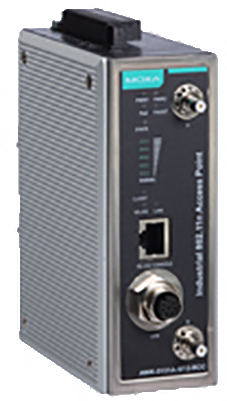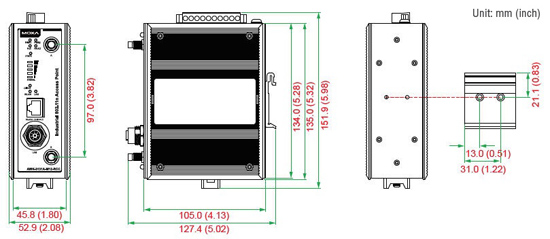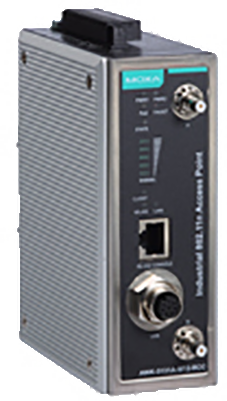MOXA AWK-3131A-M12-RCC Series
Industrial IEEE 802.11a/b/g/n wireless AP/client




- Designed specifically for rail carriage-to-carriage communication
- IEEE 802.11a/b/g/n compliant
- Up to 300 Mbps data rate
- M12 anti-vibration connectors
- MIMO technology increases data throughput and range
- Complies with a portion of EN 50155 specifications
- -40 to 75°C operating temperature range (T models)
- Supports Auto Carriage-to-Carriage connection function
The AWK-3131A-M12-RCC series industrial 802.11n wireless AP/client is an ideal wireless solution for applications such as onboard passenger infotainment systems and inter-carriage wireless backbone networks. The AWK-3131A-M12-RCC series provides a faster data rate than the 802.11g model and is ideal for a great variety of wireless configurations and applications. The auto carriage connection (ACC) feature provides simple deployment and increases the reliability of wireless carriage backbone networks. The AWK- 3131A-M12-RCC series is also optimized for passenger Wi-Fi services and complies with a portion of EN 50155 specifications, covering operating temperature, power input voltage, surge, ESD, and vibration, making the products suitable for a variety of industrial applications. The AWK-3131A-M12-RCC series can also be powered via PoE for easier deployment.
Improved Higher Data Rate and Bandwidth
- High-speed wireless connectivity with up to 300 Mbps data rate
- MIMO technology to improve the capability of transmitting andreceiving multiple data streams
- Increased channel width with channel bonding technology
Specifications for Industrial-Grade Applications
- Industrial-grade QoS and VLAN for efficient data traffic management
- Integrated DI/DO for on-site monitoring and warnings
- Signal strength LEDs for easy deployment and antenna alignment

Specification
| WLAN Interface | |
| Standards | IEEE 802.11a/b/g/n for Wireless LAN IEEE 802.11i for Wireless Security IEEE 802.3 for 10BaseT IEEE 802.3u for 100BaseT(X) IEEE 802.3ab for 1000BaseT IEEE 802.3af for Power-over-Ethernet IEEE 802.1Q for VLAN |
| Spread Spectrum and Modulation (typical) | DSSS with DBPSK, DQPSK, CCK OFDM with BPSK, QPSK, 16QAM, 64QAM 802.11b: CCK @ 11/5.5 Mbps, DQPSK @ 2 Mbps, DBPSK @ 1 Mbps 802.11a/g: 64QAM @ 54/48 Mbps, 16QAM @ 36/24 Mbps, QPSK @ 18/12 Mbps, BPSK @ 9/6 Mbps 802.11n: 64QAM @ 300 Mbps to BPSK @ 6.5 Mbps (multiple rates supported) |
| Operating Channels (central frequency) | US: 2.412 to 2.462 GHz (11 channels) 5.180 to 5.240 GHz (4 channels) 5.260 to 5.320 GHz (4 channels)* 5.500 to 5.700 GHz (8 channels, excluding 5.600 to 5.640 GHz)* 5.745 to 5.825 GHz (5 channels) EU: 2.412 to 2.472 GHz (13 channels) 5.180 to 5.240 GHz (4 channels) 5.260 to 5.320 GHz (4 channels)* 5.500 to 5.700 GHz (11 channels)* JP: 2.412 to 2.484 GHz (14 channels) 5.180 to 5.240 GHz (4 channels) 5.260 to 5.320 GHz (4 channels)* 5.500 to 5.700 GHz (11 channels)* |
| *DFS (Dynamic Frequency Selection) channel supportIn AP mode, when a radar signal is detected, the device will automatically switch to another channel. However according to regulations, after switching channels, a 60-second availability check period is required before starting the service. | |
| Security | SSID broadcast enable/disable Firewall for MAC/IP/Protocol/Port-based filtering 64-bit and 128-bit WEP encryption, WPA/WPA2-Personal and Enterprise (IEEE 802.1X/RADIUS, TKIP, and AES) |
| Transmission Rates | 802.11b: 1, 2, 5.5, 11 Mbps 802.11a/g: 6, 9, 12, 18, 24, 36, 48, 54 Mbps 802.11n: 6.5 to 300 Mbps (multiple rates supported) |
| TX Transmit Power | 802.11b: Typ. 26±1.5 dBm @ 1 Mbps Typ. 26±1.5 dBm @ 2 Mbps Typ. 26±1.5 dBm @ 5.5 Mbps Typ. 25±1.5 dBm @ 11 Mbps 802.11g: Typ. 23±1.5 dBm @ 6 to 24 Mbps Typ. 21±1.5 dBm @ 36 Mbps Typ. 19±1.5 dBm @ 48 Mbps Typ. 18±1.5 dBm @ 54 Mbps 802.11n (2.4 GHz): Typ. 23±1.5dBm @ MCS0 20 MHz Typ. 21±1.5dBm @ MCS1 20 MHz Typ. 21±1.5dBm @ MCS2 20 MHz Typ. 21±1.5dBm @ MCS3 20 MHz Typ. 20±1.5dBm @ MCS4 20 MHz Typ. 19±1.5dBm @ MCS5 20 MHz Typ. 18±1.5dBm @ MCS6 20 MHz Typ. 18±1.5dBm @ MCS7 20 MHz Typ. 23±1.5dBm @ MCS8 20 MHz Typ. 21±1.5dBm @ MCS9 20 MHz Typ. 21±1.5dBm @ MCS10 20 MHz Typ. 21±1.5dBm @ MCS11 20 MHz Typ. 20±1.5dBm @ MCS12 20 MHz Typ. 19±1.5dBm @ MCS13 20 MHz Typ. 18±1.5dBm @ MCS14 20 MHz Typ. 18±1.5dBm @ MCS15 20 MHz Typ. 23±1.5dBm @ MCS0 40 MHz Typ. 20±1.5dBm @ MCS1 40 MHz Typ. 20±1.5dBm @ MCS2 40 MHz Typ. 20±1.5dBm @ MCS3 40 MHz Typ. 19±1.5dBm @ MCS4 40 MHz Typ. 19±1.5dBm @ MCS5 40 MHz Typ. 18±1.5dBm @ MCS6 40 MHz Typ. 17±1.5dBm @ MCS7 40 MHz Typ. 23±1.5dBm @ MCS8 40 MHz Typ. 20±1.5dBm @ MCS9 40 MHz Typ. 20±1.5dBm @ MCS10 40 MHz Typ. 20±1.5dBm @ MCS11 40 MHz Typ. 20±1.5dBm @ MCS12 40 MHz Typ. 19±1.5dBm @ MCS13 40 MHz Typ. 18±1.5dBm @ MCS14 40 MHz Typ. 17±1.5dBm @ MCS15 40 MHz 802.11a: Typ. 23±1.5 dBm @ 6 to 24 Mbps Typ. 21±1.5 dBm @ 36 Mbps Typ. 20±1.5 dBm @ 48 Mbps Typ. 18±.5 dBm @ 54 Mbps 802.11n (5 GHz): Typ. 23±1.5dBm @ MCS0 20 MHz Typ. 20±1.5dBm @ MCS1 20 MHz Typ. 20±1.5dBm @ MCS2 20 MHz Typ. 20±1.5dBm @ MCS3 20 MHz Typ. 19±1.5dBm @ MCS4 20 MHz Typ. 18±1.5dBm @ MCS5 20 MHz Typ. 18±1.5dBm @ MCS6 20 MHz Typ. 18±1.5dBm @ MCS7 20 MHz Typ. 23±1.5dBm @ MCS8 20 MHz Typ. 20±1.5dBm @ MCS9 20 MHz Typ. 20±1.5dBm @ MCS10 20 MHz Typ. 20±1.5dBm @ MCS11 20 MHz Typ. 19±1.5dBm @ MCS12 20 MHz Typ. 19±1.5dBm @ MCS13 20 MHz Typ. 18±1.5dBm @ MCS14 20 MHz Typ. 18±1.5dBm @ MCS15 20 MHz Typ. 23±1.5dBm @ MCS0 40 MHz Typ. 20±1.5dBm @ MCS1 40 MHz Typ. 20±1.5dBm @ MCS2 40 MHz Typ. 20±1.5dBm @ MCS3 40 MHz Typ. 19±1.5dBm @ MCS4 40 MHz Typ. 18±1.5dBm @ MCS5 40 MHz Typ. 18±1.5dBm @ MCS6 40 MHz Typ. 18±1.5dBm @ MCS7 40 MHz Typ. 23±1.5dBm @ MCS8 40 MHz Typ. 20±1.5dBm @ MCS9 40 MHz Typ. 20±1.5dBm @ MCS10 40 MHz Typ. 20±1.5dBm @ MCS11 40 MHz Typ. 19±1.5dBm @ MCS12 40 MHz Typ. 19±1.5dBm @ MCS13 40 MHz Typ. 18±1.5dBm @ MCS14 40 MHz Typ. 18±1.5dBm @ MCS15 40 MHz |
| RX Sensitivity | 2.4 GHz 802.11b: -93 dBm @ 1 Mbps -93 dBm @ 2 Mbps -93 dBm @ 5.5 Mbps -88 dBm @ 11 Mbps 802.11g: -88 dBm @ 6 Mbps -86 dBm @ 9 Mbps -85 dBm @ 12 Mbps -85 dBm @ 18 Mbps -85 dBm @ 24 Mbps -82 dBm @ 36 Mbps -78 dBm @ 48 Mbps -74 dBm @ 54 Mbps 802.11n (2.4 GHz): -89 dBm @ MCS0 20 MHz -85 dBm @ MCS1 20 MHz -85 dBm @ MCS2 20 MHz -82 dBm @ MCS3 20 MHz -78 dBm @ MCS4 20 MHz -74 dBm @ MCS5 20 MHz -72 dBm @ MCS6 20 MHz -70 dBm @ MCS7 20 MHz -95 dBm @ MCS8 20 MHz -90 dBm @ MCS9 20 MHz -87 dBm @ MCS10 20 MHz -83 dBm @ MCS11 20 MHz -80 dBm @ MCS12 20 MHz -74 dBm @ MCS13 20 MHz -71 dBm @ MCS14 20 MHz -69 dBm @ MCS15 20 MHz -87 dBm @ MCS0 40 MHz -83 dBm @ MCS1 40 MHz -83 dBm @ MCS2 40 MHz -80 dBm @ MCS3 40 MHz -76 dBm @ MCS4 40 MHz -73 dBm @ MCS5 40 MHz -69 dBm @ MCS6 40 MHz -67 dBm @ MCS7 40 MHz -93 dBm @ MCS8 40 MHz -88 dBm @ MCS9 40 MHz -85 dBm @ MCS10 40 MHz -82 dBm @ MCS11 40 MHz -78 dBm @ MCS12 40 MHz -73 dBm @ MCS13 40 MHz -69 dBm @ MCS14 40 MHz -67 dBm @ MCS15 40 MHz 802.11a: -90 dBm @ 6 Mbps -88 dBm @ 9 Mbps -88 dBm @ 12 Mbps -85 dBm @ 18 Mbps -81 dBm @ 24 Mbps -78 dBm @ 36 Mbps -74 dBm @ 48 Mbps -74 dBm @ 54 Mbps 802.11n (5 GHz): -88 dBm @ MCS0 20 MHz -85 dBm @ MCS1 20 MHz -82 dBm @ MCS2 20 MHz -79 dBm @ MCS3 20 MHz -76 dBm @ MCS4 20 MHz -71 dBm @ MCS5 20 MHz -70 dBm @ MCS6 20 MHz -69 dBm @ MCS7 20 MHz -95 dBm @ MCS8 20 MHz -91 dBm @ MCS9 20 MHz -87 dBm @ MCS10 20 MHz -80 dBm @ MCS11 20 MHz -78 dBm @ MCS12 20 MHz -74 dBm @ MCS13 20 MHz -72 dBm @ MCS14 20 MHz -71 dBm @ MCS15 20 MHz -84 dBm @ MCS0 40 MHz -81 dBm @ MCS1 40 MHz -77 dBm @ MCS2 40 MHz -75 dBm @ MCS3 40 MHz -71 dBm @ MCS4 40 MHz -67 dBm @ MCS5 40 MHz -64 dBm @ MCS6 40 MHz -63 dBm @ MCS7 40 MHz -90 dBm @ MCS8 40 MHz -85 dBm @ MCS9 40 MHz -82 dBm @ MCS10 40 MHz -81 dBm @ MCS11 40 MHz -77 dBm @ MCS12 40 MHz -73 dBm @ MCS13 40 MHz -71 dBm @ MCS14 40 MHz -68 dBm @ MCS15 40 MHz |
| Protocol Support | |
| General Protocols | Proxy ARP, DNS, HTTP, HTTPS, IP, ICMP, SNTP, TCP, UDP, RADIUS, SNMP, DHCP |
| AP-only Protocols | ARP, BOOTP, DHCP |
| Interface | |
| M12 Ports | 1, M12 A-coded 8-pin female connector, 10/100/1000BaseT(X) auto negotiation speed, F/H duplex mode, auto MDI/MDI-X connection |
| Console Port | RS-232 (RJ45-type) |
| Reset | Present |
| LED Indicators | PWR1, PWR2, PoE, FAULT, STATE, signal strength, Client, WLAN, LAN |
| Alarm Contact (digital output) | 1 relay output with current carrying capacity of 1 A @ 24 VDC |
| Digital Inputs | 2 electrically isolated inputs +13 to +30 V for state 1 +3 to -30 V for state 0 Max. input current: 8 mA |
| Connector for External Antennas | QMA (female) |
| Physical Characteristics | |
| Housing | Metal, IP30 protection |
| Weight | 850 g (1.87 lb) |
| Dimensions | 52.9 x 151.9 x 127.4 mm (2.08 x 5.98 x 5.02 in) |
| Installation | DIN-rail mounting (standard), wall mounting (optional) |
| Environmental Limits | |
| Operating Temperature | Standard Models: -25 to 60°C (-13 to 140°F)Wide Temp. Models: -40 to 75°C (-40 to 167°F) |
| Storage Temperature | -40 to 85°C (-40 to 185°F) |
| Ambient Relative Humidity | 5% to 95% (non-condensing) |
| Power Requirements | |
| Input Voltage | 12 to 48 VDC, redundant dual DC power inputs or 48 VDC Power-over-Ethernet (IEEE 802.3af compliant) |
| Input Current | Maximum 8.03 W (12 V / 0.67 A to 48 V / 0.17 A), 25°C |
| Connector | 10-pin removable terminal block |
| Reverse Polarity Protection | Present |
| Standards and Certifications | |
| Safety | EN 60950-1(LVD), UL 60950-1, IEC 60950-1(CB) |
| EMC | EN 55032/24 |
| EMI | CISPR 32, FCC Part 15B Class B |
| EMS | IEC 61000-4-2 ESD: Contact: 8 kV; Air: 15 kV IEC 61000-4-3 RS: 80 MHz to 1 GHz: 20 V/m IEC 61000-4-4 EFT: Power: 2 kV; Signal: 2 kV IEC 61000-4-5 Surge: Power: 2 kV; Signal: 2 kV IEC 61000-4-6 CS: 10 V IEC 61000-4-8 |
| Radio | EU: EN 300 328, EN 301 893 US: FCC ID SLE-WAPN008 JP: TELEC Singapore: IDA |
| Rail Traffic | EN 50155*, EN 50121-4, EN 45545-2 |
| *Complies with a portion of EN 50155 specifications. | |
| MTBF (mean time between failures) | |
| Time | 742,649 hrs |
| Standard | Telcordia SR332 |
Available Models
| Model No. | Description |
|---|---|
| AWK-3131A-M12-RCC-EU | Industrial IEEE 802.11a/b/g/n wireless AP/client, 1 M12 Gigabit LAN port, QMA antenna interface, -25 to 60°C operating temperature, Europe band |
| AWK-3131A-M12-RCC-EU-T | Industrial IEEE 802.11a/b/g/n wireless AP/client, 1 M12 Gigabit LAN port, QMA antenna interface, -40 to 75°C operating temperature, Europe band |
| AWK-3131A-M12-RCC-EU-CT | Industrial IEEE 802.11a/b/g/n wireless AP/client, conformal coating, 1 M12 Gigabit LAN port, QMA antenna interface, -25 to 60°C operating temperature, Europe band |
| AWK-3131A-M12-RCC-EU-CT-T | Industrial IEEE 802.11a/b/g/n wireless AP/client, conformal coating, 1 M12 Gigabit LAN port, QMA antenna interface, -40 to 75°C operating temperature, Europe band |
Optional Accessories
| Model No. | Description |
|---|---|
| WK-51-01 | Wall-mounting kit, 51mm wide |
 Customers who viewed this item also viewed
Customers who viewed this item also viewed













 Properties
Properties Description
Description Further Information
Further Information



 Properties
Properties Description
Description PDF
PDF